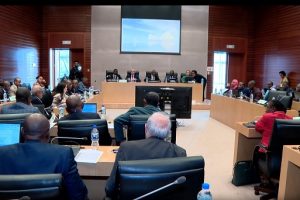BY HAFTU GEBREZGABIHER
International infrastructure aid dates back to the Marshall Plan of 1948 and has been a regular feature of foreign aid to developing countries ever since. So, what is unusual or new about the Belt and Road Initiative (BRI) is in fact, there are several aspects to the BRI that make it particularly notable even beyond China’s turnaround from borrower to lender.
On Sunday, leaders of the G7 countries backed a western rival to China’s Belt and Road Initiative, with a plan to mobilize billions of dollars to help developing countries tackle climate change. US president Joe Biden has led calls to offer poor countries a new source of infrastructure finance, providing a “democratic” alternative to Chinese loans, which are seen in the west as a tool to spread Beijing’s influence.
Leaders at the G7 summit in Cornwall will agree what allies of UK Prime Minister Boris Johnson, the summit host, call a “green belt and road” plan, with richer countries helping to fund schemes that reduce carbon emissions. Johnson wants to focus on supporting green initiatives and has been wary of presenting the initiative as an “anti-China” effort. British officials said they wanted the group of leading western economies to “show what we are for, not who we are against”. But the White House favors a wider package of infrastructure support and has been explicit about wanting to provide a counterweight to China’s influence. “We have a slightly narrower focus,” said one British official.
However, according to the report filed by Reuters, China on Sunday pointedly cautioned Group of Seven leaders that the days when “small” groups of countries decided the fate of the world was long gone, hitting back at the world’s richest democracies which have sought a unified position over Beijing.
On Saturday, G7 leaders held talks to co-ordinate China strategy. “There was broad agreement that we should co-operate with Beijing on things like fighting climate change, compete in areas like global supply chains and contest on issues like human rights,” said one official briefed on the talks. The “build back better for the world” plan will grant countries improved access to financing for low-carbon projects such as wind farms and railways.
The programme aims to boost climate funding from multilateral development banks as well as the private sector and was billed as a “green Marshall Plan” by some officials, but at a smaller scale. G7 leaders are expected to commit to increasing their contributions to international climate finance. This will help them meet a pre-existing target of mobilising $100bn a year from rich countries to help poor countries support green growth.
However, one official watching the discussions said: “It was a short on detail on how this would be achieved.” A senior US official said on Friday: “The United States and many of our partners and friends around the world have long been skeptical about China’s Belt and Road Initiative.” “We’ve seen the Chinese government demonstrate a lack of transparency, poor environmental and labour standards, and a course of approach that’s left many countries worse off. “But until now, we haven’t offered a positive alternative that reflects our values, our standards, and our way of doing business.”
China criticized the US and other G7 members, arguing that “genuine multilateralism” was based on the UN. “The days when global decisions were dictated by a small group of countries are long gone,” a spokesperson at the Chinese embassy in London said. On Friday, Yang Jiechi, the top Chinese foreign policy official, also hit back at international condemnation over Beijing’s human rights abuses in Xinjiang and erosion of Hong Kong’s autonomy.
Since its establishment in 1949, the People’s Republic of China (PRC) has viewed itself as an underdeveloped country — economically backward, physically weak, and vulnerable to exploitation by more powerful states. Even as the PRC has grown stronger economically and militarily, especially since launching the reform and opening policies of Deng Xiaoping in 1978, PRC officials continue to insist China is a developing country.
In the initial stages of reform and opening, China’s relations with the developed world were shaped by its desire to expand trade and attract investment. In the 1990s, China increased its attention to the Developing World, negotiating economic agreements and creating new China-centric institutions. This accelerated in the 2000s and especially after the 2008 financial crisis, when there were worldwide doubts about the developed-world, and especially the U.S., economic model. China’s attention to the Developing World has culminated in numerous institutions and in the new Belt and Road Initiative.
The authors analyze China’s political and diplomatic, economic, and military engagement with the Developing World, region by region, focusing on the 21st century through the beginning of the Belt and Road Initiative, an ambitious vision that builds on China’s previous activities. The authors discuss specific countries in each region — so-called pivotal states — that are most important to China. The authors show that China has oriented its security concerns and its overall engagement in concentric circles of importance. Near neighbors merit the most attention. The authors conclude with policy implications for the United States.
One interesting aspect of the BRI is that while most of the partner countries are developing countries, several are high-income countries, such as Greece and Italy. Chinese firms own stakes in over a dozen European ports. The largest such investment is by Cosco, a Chinese state-owned enterprise, which purchased a majority stake in Piraeus port in Greece in 2016 and has since invested several hundred million dollars in upgrading the port. As a result, Piraeus is now the largest container port in the Mediterranean and the fourth largest container port in Europe.
Still, success stories aside, why are countries of all stripes turning to China for funding when the world is awash with cash? Traditionally, such countries have preferred to work with the World Bank and other multilateral lenders, which provide borrowers with good practices, while making significant funding available on a meritocratic rather than political basis.
From a developing country viewpoint, accessing the world’s spare capital has been difficult because of the risk entailed in many such investments. The Asian Development Bank estimates that Asian countries face an infrastructure investment gap of $459 billion a year. Pakistan provides an example. As a poor state with weak infrastructure, Pakistan needs several billion dollars a year of foreign aid if it is to overcome its infrastructure challenges. Yet, its largest infrastructure investment, excluding the BRI projects, is a $382 million project, funded by a loan from the World Bank to develop a bus rapid transit system in the port city of Karachi.
By comparison, the BRI in Pakistan, termed the China Pakistan Economic Corridor (CPEC), will bring in investments of $62 billion over a ten-year period. The projects include transportation, communication, and energy investments that are located in overlapping zones, enabling comprehensive economic development. Already, Pakistan’s energy sector has been transformed with CPEC investments that will total $33.79 billion by 2023, and will add 17 Gw of electricity capacity to an existing base of 28 Gw, i.e., an increase of 60 per cent.
CPEC is typical of BRI projects, now under way in a number of countries. Such transformative, national-scale investment is naturally attractive to poor countries, and helps explain why they, as well as some rich countries, are willing to turn to the BRI. In return, they appear willing to accept that the investments will connect them more closely to China—this is most evident through observing the geography of projects, but also through increasing these countries’ reliance on Chinese project management and operating systems, and through transacting increasingly in renminbi.
It’s worth remembering that despite its reputation as a leading economy, China is still a middle-income country with per capita income just a quarter of that of the average high-income country. An estimated 373 million persons, or about a quarter of China’s population, still live below the poverty line. But as a nation, it has a high savings rate of about 47 per cent on an economy of over $13 trillion a year that has enabled it to channel substantial sums towards the BRI. Comparably, the United States, with a savings rate of about 19 per cent on an economic size of $21 trillion, saves less in absolute terms.
This brings us to what is likely China’s strongest motive behind the BRI: long-term economic security. The maritime routes of the BRI will help the relatively underdeveloped, landlocked areas of China such as Yunnan and Xinjiang provinces by linking them with ports in the more rapidly growing areas of Asia. At the same time, the emerging land routes of the BRI are developing an alternative to the South China Sea, through which most of China’s trade currently passes and which is becoming a zone of contestation between the United States and China.
To be sure, the onset of the COVID-19 pandemic will, in the short-run, disrupt supply chains being built up under the BRI and make funding less available. This will be a feature of all infrastructure projects, not just the BRI. China has already signaled a flexible approach to rescheduling sovereign debt. And this will likely address the main short-term concern of the borrowing countries.
Longer term, the linking of countries through the BRI’s transport, energy, and communication grids will connect people in ways previously not experienced. This may have both positive and negative consequences. For instance, improved access to essential medical supplies and trained personnel due to the BRI grid will need to be balanced by the risk of faster spread of COVID-like diseases. If, and this is not a given, poor countries use the increased wealth generated by the BRI to improve resilience to health risks, the BRI could be a valuable tool to improve their health security as well. If not, some short-term gains from the BRI could well disappear in the long-term.
(The Times of India, Financial Times and RAND Corporation)
The Ethiopian Herald June 16/2021




